| Origin | Longissimus capitis: transverse processes of C4-T4 Longissimus cervicis: transverse processes of T1-T4 Longissimus thoracis: dorsal surface of the sacrum and median sacral crest, medial surface of posterior superior iliac spine, and transverse processes of vertebrae L1-L5 |
| Insertion | Longissimus capitis: posterior edge of the mastoid process Longissimus cervicis: posterior tubercle of C2-C6 transverse processes Longissimus thoracis: transverse process of vertebrae T1-T12 and the dorsal aspect of ribs 3-12 (between the rib’s angle and tubercle) |
| Action | Bilateral contraction: extension of trunk and neck Unilateral contraction lateral flexion of the trunk and the neck |
| Nerve | Lateral branches of the corresponding spinal nerves’ posterior rami |
| Artery | Vertebral artery, deep cervical artery, occipital artery, transverse cervical artery, superior intercostal artery, posterior intercostal artery, subcostal artery, lateral sacral artery, and median sacral artery |
Location & Overview
The longissimus muscle is a large back muscle that runs parallel to the spine, extending from the sacrum to the edge of the mastoid process. It is divided into three sections, ordered from bottom to top: the longissimus thoracis, longissimus cervicis, and longissimus capitis. The longissimus is part of the erector spinae muscle group, alongside the iliocostalis and the spinalis. The longissimus thoracis is the largest and longest muscle of the group and of the back, hence its name, “longissimus” [1] [2]. Examples of the longissimus sections and the erector spinae muscle group are displayed in the below images.
The longissimus muscle plays an important role in sporting activities, such as powerlifting, where it helps to maintain spinal extension during competition lifts like the deadlift and squat. In swimming, it helps to maintain proper body position, especially during freestyle and backstroke. The iliocostalis muscle is also important for day-to-day activities, such as twisting and bending, such as reaching for an object on a high shelf or bending over to put on shoes, it assists by stabilising the spine and maintaining proper posture. It can also assist with less strenuous posture related activities, such as sitting upright and standing upright.

Displayed here we can see the longissimus muscle by itself.
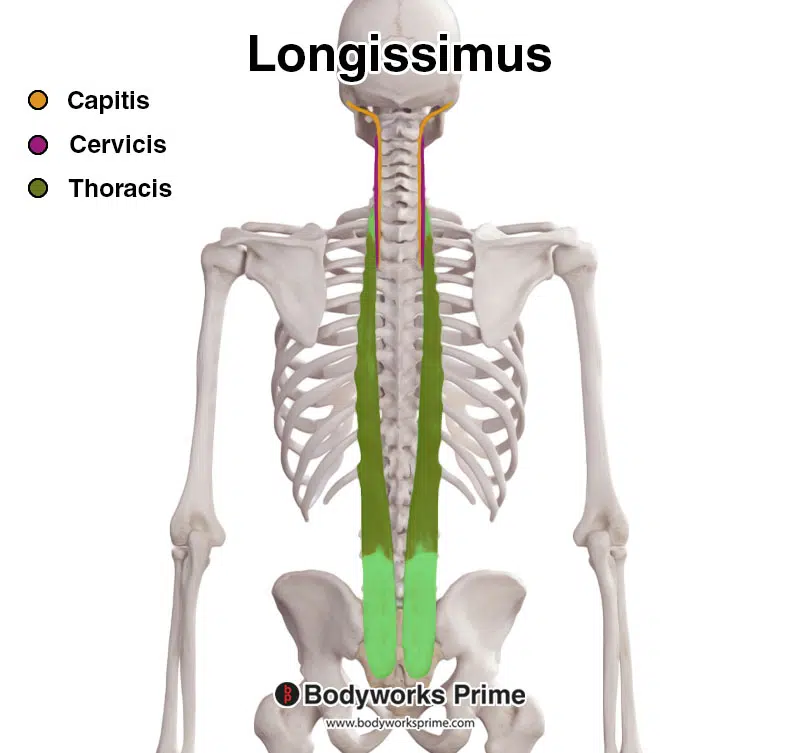
This picture shows the different sections of the longissimus muscle. The capitis is highlighted in yellow, the cervicis purple, and thoracis green.

Here we can see all three of the erector spinae muscles together.
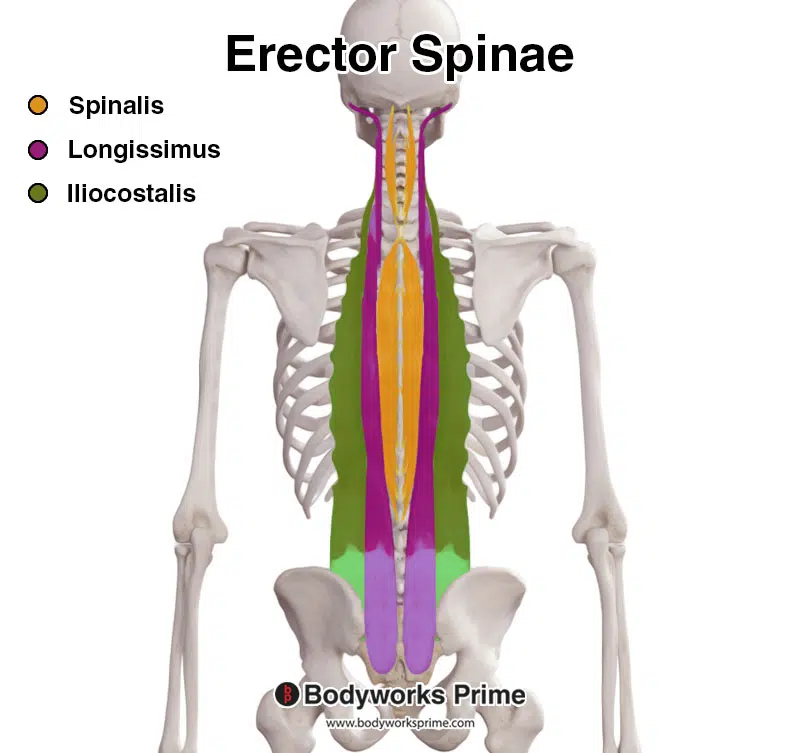
Pictured here, we can see the erector spinae muscle group. The spinalis is highlighted in yellow, the longissimus in purple, and the iliocostalis in green.
Origin & Insertion
The longissimus capitis muscle has three segments, each with different points of origin and insertion. These are:
The longissimus capitis originates from the transverse processes of C4 to T4 vertebrae and inserts at the posterior edge of the mastoid process [3].
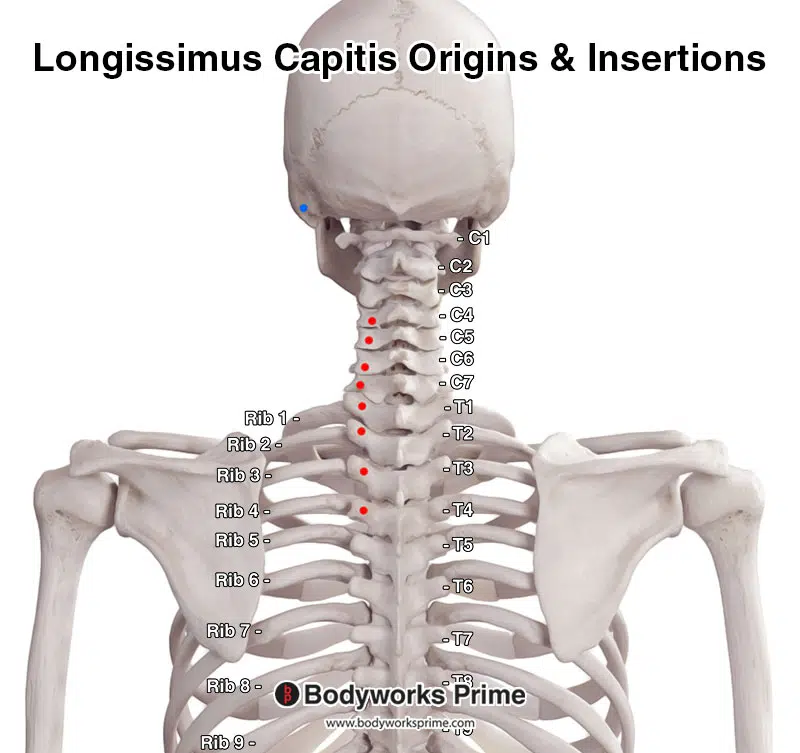
This image shows the points of origin and insertion of the longissimus capitis segment, with the origin points marked in red and the insertion points highlighted in blue.
Note: For the sake of simplicity, only the left side of the muscle is displayed here. However, the origins and insertions are duplicated on the right-hand side as well.
The longissimus cervicis originates from the transverse processes of T1 to T4 vertebrae and inserts at the posterior tubercle of C2 to C6 transverse processes [4].

The points of origin and insertion of the longissimus cervicis are displayed in this picture, with the origin points marked in red and the insertion points marked in blue.
Note: For the sake of simplicity, only the left side of the muscle is displayed here. However, the origins and insertions are duplicated on the right-hand side as well.
The longissimus thoracis originates from the dorsal surface of the sacrum and its median sacral crest, the medial surface of the posterior superior iliac spine, and the transverse processes of L1 to L5 vertebrae. It inserts at the transverse processes of T1 to T12 vertebrae and the dorsal aspect of ribs 3 to 12, between the rib angle and tubercle [5]

In this picture are the origins and insertions of the longissimus thoracis section, with origins highlighted in red and insertions highlighted in blue.
Note: For the sake of simplicity, only the left side of the muscle is displayed here. However, the origins and insertions are duplicated on the right-hand side as well.
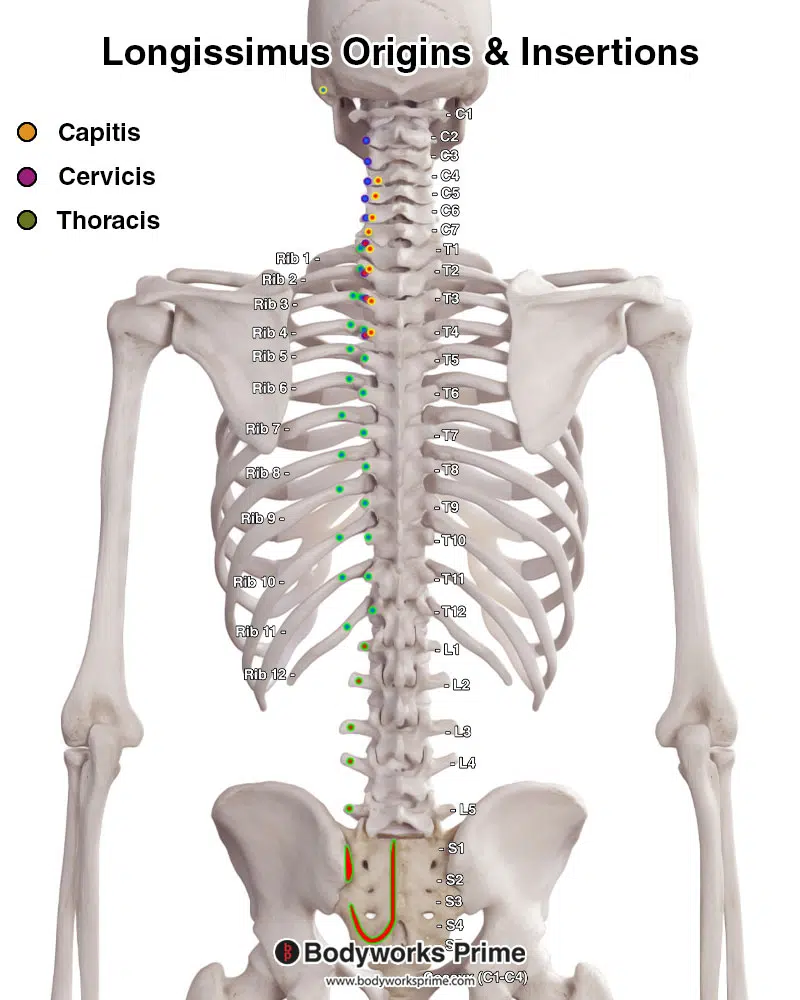
Pictured here are the origins and insertions of the longissimus thoracis, cervicis, and capitis, with origins highlighted in red and insertions in blue. The capitis has a yellow highlight around it, the cervicis has a purple highlight and the thoracis has a green highlight.
Note: For the sake of simplicity, only the left side of the muscle is displayed here. However, the origins and insertions are duplicated on the right-hand side as well.
Actions
The actions of the longissimus muscle are dependent on whether it contracts bilaterally (both sides contracting) or unilaterally (one side contracting). In the case of bilateral contraction, it results in extension of both the trunk and the neck. A unilateral contraction, on the other hand, results in lateral flexion of the trunk and the neck. However, it is important to note that the specific actions that occur on each segment of this muscle will depend on which portion of the spine they cross. To better understand which parts of the back are influenced by each segment, you can refer to the accompanying illustrations further up the page. For example, the capitis section originates from C4-T4 and inserts onto the mastoid process. Since the longissimus capitis is located near the top of the back and neck, the capitis section mainly influences movements at the neck and the upper thoracic vertebrae. On the other hand, the longissimus thoracis ends before reaching the neck (at T1), so it has no actions at the neck, but can influence movements of the trunk [6] [7].
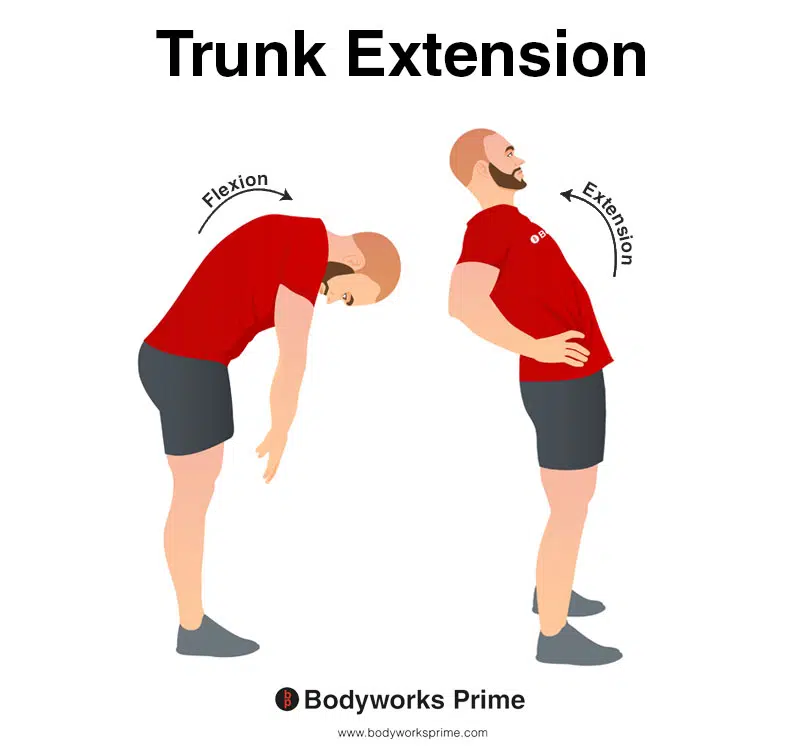
This image shows an example of trunk extension, which involves arching or bending the spine/torso/back backwards. The opposite of trunk extension is trunk flexion. The longissimus thoracis section is involved in trunk extension. The extension is the result of a bilateral contraction.

This image demonstrates trunk lateral flexion, which involves bending the torso to the side. The longissimus thoracis section is involved in trunk lateral flexion. The lateral flexion is the result of a unilateral contraction.

This image demonstrates neck extension, which involves bending the neck backwards. The opposite of neck extension is neck flexion. The longissimus cervicis and capitis sections are involved in neck extension. The extension is the result of a bilateral contraction.
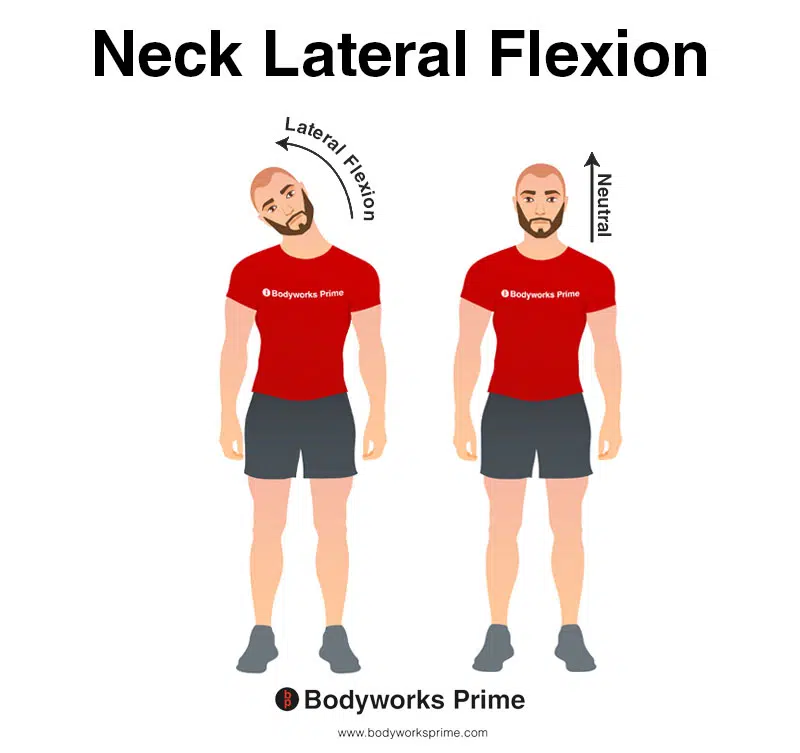
This image demonstrates neck lateral flexion, which involves bending the neck to the side. The opposite of neck lateral flexion is neck lateral extension. The longissimus cervicis and capitis sections are involved in neck lateral flexion. The lateral flexion is the result of a unilateral contraction.
Innervation
The longissimus muscle is innervated by the lateral branches of the corresponding spinal nerves. As a result, the portions of the longissimus that traverse the cervical spine will receive innervation from the lateral branches of the cervical spinal nerves’ posterior rami. The thoracic portion of the muscle will be innervated by the lateral branches of the thoracic spinal nerves’ posterior rami. And the lumbar portion will receive innervation from the lateral branches of the lumbar spinal nerves’ posterior rami [8] [9].

Pictured here is a cross-section of a lumbar vertebra. One of the labeled parts is the ‘dorsal ramus’, which is also known as the ‘posterior ramus’. Each segment of the erector spinae muscles receives innervation from the posterior ramus of the corresponding spinal nerve. In other words, the part of the muscle aligned with a specific spinal segment is innervated by that specific spinal nerve’s posterior ramus.
Blood Supply
The longissimus capitis and cervicis are supplied with blood by the vertebral artery, deep cervical artery, occipital artery, and transverse cervical artery. Meanwhile, the longissimus thoracis receives blood supply from the superior intercostal artery, posterior intercostal artery, subcostal artery, lateral sacral artery, and median sacral artery.
Want some flashcards to help you remember this information? Then click the link below:
Longissimus Flashcards
Support Bodyworks Prime
Running a website and YouTube channel can be expensive. Your donation helps support the creation of more content for my website and YouTube channel. All donation proceeds go towards covering expenses only. Every contribution, big or small, makes a difference!
References
| ↑1, ↑5, ↑6, ↑8 | Cramer, G. D., & Darby, S. A. (2014). Clinical anatomy of the spine, spinal cord, and ANS (3rd ed.). St. Louis: Elsevier. ISBN 9780323079549. |
|---|---|
| ↑2, ↑7, ↑9 | Moore KL, Agur AMR, Dalley AF. Clinically Oriented Anatomy. 8th ed. Philadelphia: Lippincot Williams & Wilkins; 2017. |
| ↑3, ↑4 | Henson B, Kadiyala B, Edens MA. Anatomy, Back, Muscles. [Updated 2022 Aug 25]. In: StatPearls [Internet]. Treasure Island (FL): StatPearls Publishing; 2022 Jan-. Available from: https://www.ncbi.nlm.nih.gov/books/NBK537074/ |










